
How to Train a Dog to Accept a Collar: Tips & Tricks
Share
Training your beloved canine companion to comfortably wear a collar is a pivotal step in ensuring their safety and integrating them into your daily routines. For health-conscious pet owners, understanding how to train a dog to accept a collar not only contributes to your pet's well-being but also enhances your relationship with them. This article provides a comprehensive guide to help you with this crucial aspect of dog training.

Understanding the Importance of a Collar
Before diving into the training techniques, its essential to recognize the significance of a collar. A collar is more than just an accessory; it serves as an identity marker and a safety measure. It can hold your dog's ID tags and is crucial for leash training. For more insights into dog accessories, check out recycling old dog collars.
Choosing the Right Collar for Your Dog
The first step in making your dog comfortable with a collar is selecting the right one. Consider your dog's size, breed, and activity level. A lightweight, durable collar is ideal for most dogs. For specific tips on measuring your dog for a collar, you might find this guide helpful.
Types of Collars
There are various types of collars, each suited for different purposes:
- Flat collars: The most common type, suitable for everyday use.
- Martingale collars: Ideal for dogs that tend to slip out of their collars.
- Training collars: Used for specific training purposes, such as citronella collars.
Steps to Train Your Dog to Accept a Collar
Once you've selected the appropriate collar, follow these steps to train your dog to accept it:
Introduce the Collar Gently
Allow your dog to sniff and examine the collar. Use positive reinforcement by giving treats and praise when they show curiosity without fear. This initial step is crucial to create a positive association.
Gradual Wearing
Start by placing the collar on your dog for short periods. Gradually increase the time as your dog becomes more comfortable. During this process, engage them in fun activities to distract from any initial discomfort.
Positive Reinforcement
Each time you put the collar on your dog, reward them with treats and affection. This reinforcement will help establish a positive connection with wearing the collar.
For more comprehensive training tips, visit how to manage barking.
Dealing with Common Challenges
Its not uncommon for dogs to resist wearing a collar. If your dog scratches at the collar or seems uncomfortable, ensure its not too tight. You should be able to fit two fingers between the collar and your dog's neck. If you're facing persistent issues, consider exploring common e-collar mistakes.
Addressing Anxiety
Some dogs may experience anxiety when first wearing a collar. To alleviate this, engage them in calming activities and ensure their environment is supportive. Understanding how to train a dog to accept a collar involves patience and empathy.
Regular Check-Ins
Regularly check your dog's collar for any signs of wear and tear or discomfort. Adjust the fit as your dog grows or loses weight. DIY projects can also be a fun way to create custom collars.
Maintaining a Healthy Routine
Incorporate the collar into your dog's daily routine to ensure they become accustomed to wearing it. Consistency is key to successful training. For more lifestyle tips, explore beginner's guides to other pet activities.

FAQs
Why is my dog resisting the collar?
Your dog might be resisting the collar due to unfamiliarity or discomfort. Its important to introduce it gradually and ensure its the correct size.
How tight should the collar be?
The collar should be snug but not tight. You should be able to fit two fingers between the collar and your dog's neck.
Can I leave the collar on all the time?
While its generally safe to leave the collar on during the day, its advisable to remove it at night to allow your dog's skin to breathe.
This article contains affiliate links. We may earn a commission at no extra cost to you.
